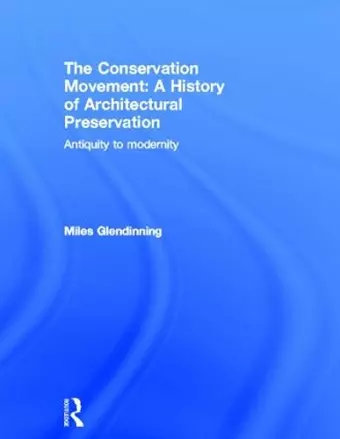The Conservation Movement: A History of Architectural Preservation
Antiquity to Modernity
Format:Hardback
Publisher:Taylor & Francis Ltd
Published:21st Jan '13
Currently unavailable, and unfortunately no date known when it will be back
This hardback is available in another edition too:
- Paperback£63.99(9780415543224)

Winner of the 2016 Antoinette Forrester Downing Award presented by the Society of Architectural Historians.
In many cities across the world, particularly in Europe, old buildings form a prominent part of the built environment, and we often take it for granted that their contribution is intrinsically positive. How has that widely-shared belief come about, and is its continued general acceptance inevitable?
Certainly, ancient structures have long been treated with care and reverence in many societies, including classical Rome and Greece. But only in modern Europe and America, in the last two centuries, has this care been elaborated and energised into a forceful, dynamic ideology: a ‘Conservation Movement’, infused with a sense of historical destiny and loss, that paradoxically shared many of the characteristics of Enlightenment modernity. The close inter-relationship between conservation and modern civilisation was most dramatically heightened in periods of war or social upheaval, beginning with the French Revolution, and rising to a tragic climax in the 20th-century age of totalitarian extremism; more recently the troubled relationship of ‘heritage’ and global commercialism has become dominant.
Miles Glendinning’s new book authoritatively presents, for the first time, the entire history of this architectural Conservation Movement, and traces its dramatic fluctuations in ideas and popularity, ending by questioning whether its recent international ascendancy can last indefinitely.
Miles Glendinning’s new book significantly deepens our knowledge and appreciation of the conservation movement. In a critical, learned, deeply thoughtful and fast-paced narrative, Glendinning vividly relates the process of making, discovering and transforming heritage to the mainsprings of geopolitics and intellectual history. Focusing on the 20th century, he wisely steers clear of normative judgments – lending clarity to his interpretation of conservation debates and rendering this volume extremely useful to both historians and conservation/design professionals. – Professor Randall Mason, Chair, Graduate Program in Historic Preservation, The University of Pennsylvania School of Design
"A fascinating read" -The Architectural Review
"This book brings vividly before our eyes the astonishing story of an astonishing movement, in all its diverse facets." -Die Denkmalpflege
"With his familiar verve, Miles Glendinning, professor of architectural conservation at the University of Edinburgh, successfully confounds this preconception [that the subject has little new to tell us] with a combination of challenging insight and analysis that places evolving battles for the ethical high ground in conservation in the context of unfolding patterns of world events: revolutions, wars, and political and socio-economic transformations." -
Dennis Rodwell, Context"Miles Glendinning’s new book significantly deepens our knowledge and appreciation of the conservation movement. In a critical, learned, deeply thoughtful and fast-paced narrative, Glendinning vividly relates the process of making, discovering and transforming heritage to the mainsprings of geopolitics and intellectual history. Focusing on the 20th century, he wisely steers clear of normative judgments – lending clarity to his interpretation of conservation debates and rendering this volume extremely useful to both historians and conservation/design professionals." –Professor Randall Mason, Chair, Graduate Program in Historic Preservation, The University of Pennsylvania School of Design
"...incorporating 12 chapters, the author gives an in-depth accounting of heritage, generously peppered with black-and-white photographs, drawings, and some maps....Glendinning leaves readers with challenging questions for the future of conserving the built environment." –L. B. Allsopp, University of Oregon
ISBN: 9780415499996
Dimensions: unknown
Weight: 1200g
544 pages